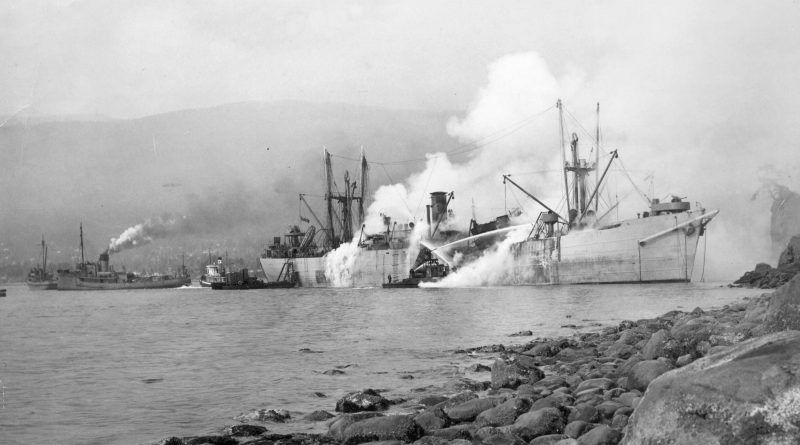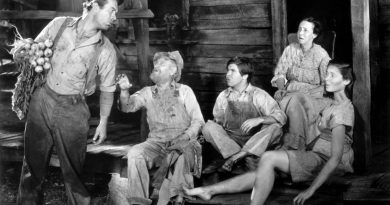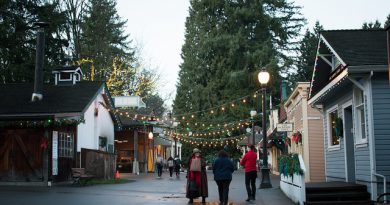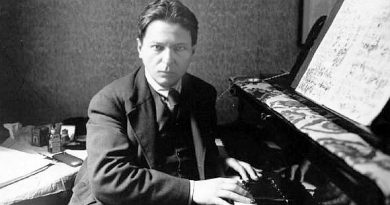1945
Above: S.S. Greenhill Park on fire after explosion
[Image: Vancouver City Archives AM1376-: CVA 1376-687]
*****************************************
You’ll note that these years include events listed under “Also in . . .” These are events for which we don’t have a specific date. If YOU know the specific date of an event shown there, please notify us . . . and cite the source! Many thanks!
*****************************************
January 28 Book trade executive Nick Hunt was born.
January Charles Cotterell, CPR assistant general manager since 1934, became president of the Vancouver Board of Trade. He died February 14, 1946, just a little over a year later.
February 20 The first family allowance cheques were mailed by the federal government.
March 2 Emily Carr, artist and writer, died in Victoria, aged 73. She was born December 13, 1871 in Victoria. In 1899, writes Constance Brissenden, she travelled to Ucluelet on Vancouver Island, the first of many trips to paint Native sites. After travels to Europe, Toronto and the Cariboo, Carr moved to Vancouver in January 1906, renting a studio at 570 Granville. She taught art classes from 1908 to 1910. After travels in B.C. and abroad she returned to Vancouver in 1912, renting a studio at 1465 W. Broadway. In March 1912 she exhibited paintings she had created in France. In April 1913 she rented Vancouver’s Drummond Hall and showed 200 paintings before returning to Victoria to live on family property. Later in life, encouraged by Ira Dilworth, she wrote books including Klee Wick and The Book of Small. She was awarded an honorary degree (D.Lib) by UBC in 1945. Read Dear Nan, Letters of Emily Carr, Nan Cheney and Humphrey Toms, edited by Doreen Walker.
March 6 The freighter Greenhill Park exploded in Vancouver Harbour, killing eight men, and breaking hundreds of downtown windows. She was towed to Siwash Rock, where the fire was finally extinguished. A later inquiry pointed to improper stowage of flammable cargo and explosives, and improper use of matches. See this longer article.
March Anne Frank, 15, died in Belsen Belsen concentration camp in Germany.
April 6 Coevorden, the Dutch city from which Capt. George Vancouver’s family derived its name, was liberated from Nazi occupation by Canadian forces. In a happy coincidence, April 6 is the City of Vancouver’s birthday! Coevorden has a web site: www.coevorden.com (in Dutch, of course!)
April 12 US president Franklin D. Roosevelt died.
April 18 Publisher and writer Howard White was born in Abbotsford. He will make his name with Raincoast Chronicles, a regional journal. He is described in BC Bookworld as “one of the key figures in the evolution of British Columbia culture.” Barry Broadfoot said, “Howard White and his Harbour Publishing have done more for regional writers, the history of the West Coast, its people, its character, its fast-fading uniqueness, than any other publisher in North America—hell, in the world.” Guess who’ll be publishing The History of Metropolitan Vancouver? See this site.
Also April 18 A pre-school for deaf kids began at Lord Tennyson School.
April 25 The United Nations began operations in New York City.
April 30 Fire destroyed Capilano Stadium in Vancouver. The fire continued past midnight into May 1. It would be rebuilt quickly (and would be renamed Nat Bailey Stadium in 1978.)
May 7 At 7:04 a.m. air raid sirens began to blare out all over wartime Greater Vancouver to mark VE Day (Victory in Europe.) Now attention would turn to defeating Japan.
May 16 Prime Minister Mackenzie King opened the federal election campaign with a speech from Vancouver broadcast over Radio CBR (now CBU).
May 22 The first veteran moved into the first of the new veterans’ homes.
May 25 Writer W.P. Kinsella, who has lived in White Rock and Vancouver and now lives in the Fraser Canyon, was born in Edmonton. He has written much, is most well known for his novel Shoeless Joe. Says the web site BC Bookworld in a long and interesting article on Kinsella: “After a young American editor in Boston named Larry Kessenich saw a brief synopsis of W.P. Kinsella’s short story called Shoeless Joe Jackson Comes to Iowa in Publisher’s Weekly, he contacted Kinsella and asked for a novel. Shoeless Joe became the basis for the 1989 Kevin Costner movie Field of Dreams . . .”
June 11 Gerry McGeer was named to the Senate.
July 12 That’s the date on this photograph of 23-year-old 2d Lieut. Molly Bobak photographed at work painting in London, England. Born in Vancouver, Molly Lamb studied at the Vancouver School of Art from 1938 to 1941. In November 1942 she enlisted as a draughtsman in the Canadian Women Army Corps (CWAC), the only woman to be hired as an official war artist. She worked on the design of the decor and costumes for the Army Show in Toronto and took 3rd Prize in the Canadian Army Art Exhibition presented at the National Gallery of Canada in 1944. She was posted to Holland after V-E (Victory in Europe) Day, and painted the tasks and experiences of female soldiers overseas.
In 1950, she obtained a grant from the government of France that allowed her to paint in France. She returned there in 1960, at the invitation of Air France, which asked her to lead a tour in Paris. A Canada Council grant allowed her to spend much of the year in Europe painting.
July 14 A remarkable story by the Province’s Jean Howarth told of a young man named Ivan Knopski—he ran a concession stand at St. Paul’s Hospital—who was building his own house at the corner of Main Street and East 29th Avenue. Knopski was blind. “His neighbors, as they watched him building, didn’t believe that. They were sure he was boasting, that he had some sight left. But when they heard his hammer going on into the night till 11 and 12 and no lanterns around, then they knew he must be telling the truth.”
July 16 The first atom bomb was exploded in a test at Alamogordo, New Mexico.
July 20 Businessman A.J.T. Taylor died in New York, aged 57. Alfred James Towle Taylor was born in Victoria August 4, 1887. He founded Taylor Engineering in 1912 which built large projects around the province. He promoted the development of British Pacific Properties and the construction of Lions Gate Bridge in the 1930s. Taylor worked for the British ministry of aircraft production in London during the Second World War. Taylor Way in West Vancouver is named for him.
August 1 Mary Louise Bollert, UBC’s first dean of women, died in Vancouver, aged about 61. She was born in 1884 in Guelph, Ont. She was a graduate of the University of Toronto (BA, 1906), and of Columbia University (MA, 1908). Bollert, writes Constance Brissenden, was director of women’s education and social welfare programs in Toronto, then dean of women at Regina College from 1914 to 1921. She was appointed the first dean of women at UBC in 1921, officially “advisor to women students,” with a salary far below that of male deans. She was a founder of the B.C. Teachers Federation. A delegate to many international women’s conferences, she was one of 12 deans of women invited to tour Japan in 1934. From 1929 to 1930 she was president of the Confederation of University Women. Read: It’s Up to You: Women at UBC in the early years by Lee Stewart.
August 4 Froth on beer glasses in B.C.’s beer parlors was now limited by law to half an inch.
August 6 The atom bomb was dropped on Hiroshima.
August 7 A headline in the Province: CITY MAN SAYS HE DISCOVERED ATOMIC POWER! News of the atom bomb’s destruction of Hiroshima brought forth an intriguing tale: “Convinced,” the paper reported, “that an invention of his that ‘draws power out of the air’ is basically the same as the atomic bomb, Louis P. Isaacs, 1184 Nelson street, said today he had written a letter to His Majesty the King appealing for protection of his inventor’s rights. Mr. Isaacs has driven himself on a bicycle chassis powered by a device which, he says, harnesses electricity from the air; he claims to have developed heat with it and to have lit lamps . . .”
August 9 The atom bomb was dropped on Nagasaki.
August 14 Japan surrendered and the Second World War ended. The victory was wildly celebrated in Greater Vancouver . . . and, oh yes, elsewhere, too.
August 21 Writer, novelist and poet George Payerle was born in Vancouver. A 1987 novel is Unknown Soldier. See this site.
August 22 Locomotive 374, which pulled the first CPR passenger train into Vancouver in 1887, arrived in the city for a last run before being put on outdoor display in Kitsilano.
September 1 Visiting movie actress Yvonne De Carlo (born September 1, 1922 as Peggy Middleton in Vancouver) celebrated her birthday at the Hotel Vancouver’s Panorama Roof. She was appearing here as part of an “Yvonne De Carlo Week” in the city. De Carlo had appeared in, among others, Salome Where She Danced (the 1945 role that made her a star), and as a handmaiden (uncredited) in the 1942 Hope/Crosby comedy Road to Morocco. She lives in California today. Check out this site. Howard Hughes made his first visit to Vancouver about this time, at the controls of his own plane. We can date the visit because he met (and, some say, romanced) the lovely Miss De Carlo while here. And, according to an article by Aaron Chapman in the Courier (December 16, 2004), he also played golf at the Capilano Golf Course.
September 5 Cipher clerk Igor Gouzenko walked out of the Soviet embassy in Ottawa. He revealed the existence of a Soviet spy ring in Canada. This has sometimes been called the event that marked the onset of the Cold War.
September 8 Henry Reifel, brewer, died in Vancouver, aged 76. He was born April 2, 1869 in Spiyer, Bavaria. Reifel emigrated to the US in 1886, Constance Brissenden writes, and began brewing in Portland and San Francisco. He came to Vancouver in 1888 and began a brewery at Main and 16th on Brewery Creek. By 1908 he had built Canadian Brewing and Malting (at 11th and Yew), and later amalgamated several companies into Vancouver Breweries, which he sold to Carling O’Keefe. Reifel developed a technique to produce malt from rice and opened Anglo-Japanese Brewing in Japan. He bought the land that is now Reifel Island in 1927. He sold his brewing interests on retirement in 1933. He donated the property for the original Vancouver Art Gallery on Georgia Street, a few blocks west of the present gallery. For information on the Reifel Migratory Bird Sanctuary, click here.
September 10 A news report datelined Portland, Oregon: “Following consultations with Dr. Gerald Wendt, noted scientist, the Pacific Northwest Trade Association . . . approved appointment of a committee to collaborate with its fisheries committee in consulting with University of Washington scientists and others on the advisability of utilization of the atomic bomb to blast out Ripple Rock, navigation hazard on Canada’s route to Alaska.” Yikes! The rock was later taken out with conventional explosives.
September 14 Three VFD firefighters were killed fighting a fire in the McMaster Building on Homer Street.
October 3 We have a note that with the war over for more than a month, coal was rationed in BC at one ton per household. An expansion of this report (for example, “one ton” per what?) would be appreciated by us. If you know more, please contact us here.
October 22 Deejay Fred Latremouille was born.
October 28 Tomekichi Homma, labor contractor and civil rights activist, died in Slocan, B.C., aged 80. He was born June 6, 1865 in Onigoshi-mura, Chiba-ken, Japan. He came to Canada at age 18 and settled in Steveston. He fished the Fraser from 1892, at first in an open Columbia boat. From 1897 to 1899 he was chairman of the Japanese Fishermen’s Benevolent Society. “This group,” says the Steveston Museum, “built the first hospital in Steveston to deal with outbreaks of typhoid amongst the fishermen living in crowded, unsanitary housing along the waterfront.” In May 1899, with Tadaichi Nagao, Homma began contracting laborers to the CPR. “Between 1900 and 1902,” the Museum continues, “he fought for voting rights for Japanese-Canadians, winning in the Canadian Supreme Court but losing in the British Privy Council. He died in an internment camp in Slocan in 1945 . . .” Homma started the first Japanese newspaper in Vancouver. An elementary school in Richmond is named for him.
Japanese Americans had been allowed to return to the coast in 1945, before the war ended, but it wasn’t until 1949 that the Canadian exile was actually over. That same year, the federal government finally granted Japanese Canadians the right to vote.
November 1 After RCAF war service, Samuel Patrick Cromie, 27, third son of Robert Cromie (who founded the Vancouver Sun) returned to the Sun to begin work today as mechanical superintendent. (Before the war he’d worked in the circulation department and as a pressman.) He was soon made vice president.
November 5 The Boeing Aircraft Co. factory on Coal Harbour—pretty much inactive with the end of the war—was to be sold to B.C. Packers, likely for use as a maintenance plant for their fishing fleet. “The big building, the main Boeing plant before the war added the Sea Island hangar and shops [in Richmond], would be used for the present as a net and gear storage loft . . . The building has a 132-foot frontage on West Georgia, extending back to the water’s edge.”
November 6 Vancouver’s city council cancelled an order that had established separate swimming days at Crystal Pool for non-white people. The pool, the Province reported, “is now open to everyone, all the time, regardless of race, creed, or colour. Park Board commissioners at a special meeting voted to withdraw previous rules about special days for whites, negroes, and Orientals.”
December 8 Jonathan Rogers, pioneer, contractor and philanthropist, died in Vancouver, aged 80. He was born July 30, 1865 on a farm, “Plas Onn,” in Denbighshire, Wales. He learned to speak English at age 16. Rogers, 21 at the time, was the first person to step down onto the platform on the arrival of the first CPR passenger train at Vancouver May 23, 1887. He was a painter, later builder and contractor. Rogers built up more than 1,000 feet of frontage along Granville and Hastings including the Rogers Building (1911), the handsome white terra cotta building at the northeast corner of Granville and Pender. He was a Vancouver alderman in 1906 and again in 1911.
As a Vancouver parks commissioner and chair (1908-43), he maintained Stanley Park in its natural state. There is a very good biographical sketch by Eifion Williams at this site, a portion of which reads: “Jonathan Rogers died in 1945 and left what at that time was a very large sum of money, a quarter of a million dollars, to various causes in Vancouver. The largest single bequest of $100,000 was given to the City of Vancouver to create a neighbourhood park in a poorer part of the city. After several delays, the park was finally opened in 1958 and called Jonathan Rogers Park in his memory.” That park is on East 7th Avenue. Rogers and his wife Elisabeth were arts patrons and world travelers. They loaned paintings from their collection to the Vancouver Art Gallery.
December Burrard Dry Dock let go the last of its female workers. Out of a work force of 13,000 a thousand women worked at the plant, where, at the war’s height, 34 “Victory” ships were built in 26 months. (When victory was announced, some women workers found themselves in tears knowing their jobs had ended and that, despite a fight by their union to keep them on, the returning men would necessarily put them out of work.)
Also in 1945
H.E. Bond became president of the Vancouver Real Estate Board.
Manitoba-born Sam Bass, 30—the son of Jewish farmer immigrants from Kiev, Ukraine—borrowed money and bought Schoff’s Drug Store at Main and Union in Vancouver, renamed it London Drugs. It almost didn’t happen: Bass, who’d been an RCAF pharmacist during the Second World War, was actually heading for California when he stopped over in Vancouver. Bass sold the chain to a U.S. firm in 1968, died in Vancouver November 8, 1990 at 75. (Today, London Drugs is owned by Vancouver-based Tong Louie, has thrived, now has 52 stores in B.C. and Alberta with more than 6,000 employees.)
George Frederick Curtis became the first Dean of the fledgling Law Faculty at the University of British Columbia. He had graduated from the University of Saskatchewan in 1927 and was named a Rhodes Scholar. He earned a BA in Jurisprudence in 1930 and a BCL at Oxford in 1931—achieving first class honors in each. After a number of years spent in private practice in Halifax and teaching at Dalhousie University, Curtis was hired by UBC. When he received the Order of British Columbia in 1995, his citation read in part: “He arrived at a time when there was little money, no facility to house its first class, and no library. Undaunted by these challenges he took the initiative and recruited judges and practitioners as voluntary lecturers, to supplement himself and one other professor. The faculty he created was pluralistic and tolerant, enriched by teachers from differing backgrounds contributing different points of view.” The George F. Curtis Building at UBC is named for him. He was dean for 26 years, stepping down in 1971.
Seattle brewer Emil Sick bought Capilano Stadium. It was in bad shape, and wouldn’t open until June 15, 1951.
After his return from a German prisoner of war camp. Saskatchewan born Art Seller took advantage of the postwar flying boom: in partnership with Harold Foster, whom he later bought out, he formed the Royal City Flying Club at Vancouver Airport. It had one war surplus Tiger Moth. Later, a second Moth was added. Get more of this really interesting story here.
The United Fishermen and Allied Workers Union was organized.
Lansdowne race track was sold to the B.C. Turf and Country Club.
The first Cloverdale Rodeo was staged.
After six years D. MacKay ended his term as chief of the Vancouver Police Department, and was succeeded by A.G. McNeill.
Walter Moberly Elementary School, built in 1911, burned down. It was rebuilt in 1946. It’s at 1000 East 59th Avenue.
W.H. Malkin steps down as chair of the board of governors of the British Columbia Cancer Institute, and was succeeded by Dr. A. Maxwell Evans, who serves for 33 years.
B.C. members of the Fraternal Order of Eagles (established in 1898 in Seattle) form the first Provincial Aerie.
CKWX became an affiliate of the US-based Mutual Broadcasting System.
The magazine BC Outdoors began publishing.
The Hollyburn, built in 1936 for the West Vancouver Municipal Ferry system, was sold to Harbour Navigation. She was busy during Expo 86.
The provincial government created the B.C. Power Commission, which began extending electricity into rural areas.
Weldwood’s manufacturing operations in British Columbia began this year when a predecessor company, Western Plywood, began producing fir and poplar plywood in a Vancouver plant.
The first mall in Canada, West Vancouver’s Park Royal Shopping Centre, was heralded as innovative state-of-the-art shopping at its launch this year. Developed by British Pacific Properties, it marked the concept of a major store as an anchor, (in this case Woodward’s) attached to a handful of smaller shops and surrounded by ample free parking. It would undergo several expansions and a major addition to the south on the other side of Marine Drive.
Aragon Recording opened at 615 W. Hastings. One of its founding partners, broadcaster and musician Al Reusch, would acquire sole ownership of the three-room space in 1954.
Rockstar manager, promoter, etc., Bruce Allen was born.
Teacher, writer and editor Catherine Kerr was born in Vancouver. See this site.
Writer, columnist and Member of Parliament Paul St. Pierre (his books include Breaking Smith’s Quarter Horse; Smith and Other Events, many others), born in Chicago in 1923, came to Vancouver. His 1950s CBC television series ‘Cariboo Country’ (which launched the acting career of Chief Dan George) will be a huge hit.
Botanist Gerald Straley was born. His invaluable Trees of Vancouver (UBC Press, 1992) identified 470 varieties of trees—and where to find them—in the Lower Mainland. It received the 1993 City of Vancouver Book Award. See this site.
Michael Walsh was born in Toronto. A long-time film critic for the Province, he wrote The Canadian Movie Quiz Book in 1979 and contributed the section on Vancouver-made films for 1997’s The Greater Vancouver Book., He came to B.C. in 1969.
In 1945, the city agreed to provide $1 million for a new main library to replace the 1901 Carnegie building. It won’t open, however, for another nine years.
Poet Earle Birney won the second of his Governor General’s awards for poetry. He won the first in 1942.
Vancouver-born movie actor John Ireland, 30, appeared in his first film, A Walk in the Sun.
Mary Pack, dismayed by the lack of services for physically handicapped children in Vancouver, started the B.C. Spastic Society. That would become the B.C. Division of the Canadian Arthritis and Rheumatism Society in 1948.
Italy-born Joe Philliponi (born Filippone), about 32, opened The Penthouse dinner club at 1019 Seymour. It’s still there, 60 years later. Philliponi would be shot to death in his office September 18, 1983.
Broadcaster Bill Good, Jr. was born.
Forestry executive W.J. VanDusen became senior vice president at H.R. MacMillan Export.
Foon Sien Wong, a spokesman for Chinese rights, began a fight to get the vote for Chinese Canadians.




